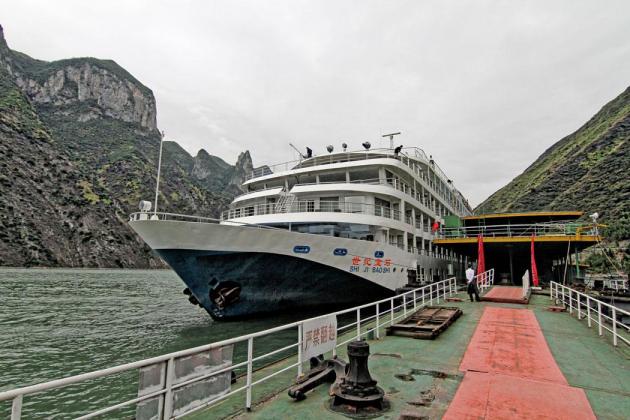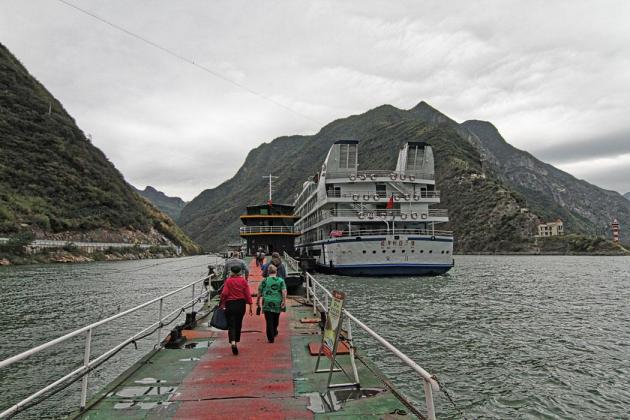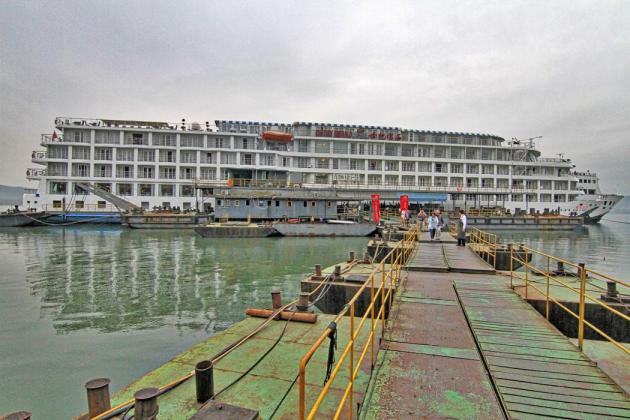BONJOUR WORLD: Take a slow trip to China and see it all on Viking Cruises
I have for years been telling everyone I wanted to take a cruise along the Yangtze River in China. Finally, my constant putting the word out resulted in my doing just that. While you might be thinking all cruising all the time, since my 21-day trip was a little under half of the time spent on the river coupled with a very rich land itinerary as well. The Viking Cruise package I chose was Undiscovered China and along with time spent on the Emerald Cruiser, this was coupled with a unique exploration in parts of the country that give an entirely new meaning to the term planes, trains and ships.
The story begins as all good travel stories do, arriving at the destination. In this case Shanghai. Ready, willing and able to get my Undiscovered China trip underway, the first few nights were spent in the Four Seasons Shanghai where I immediately discovered the airline had destroyed the handle on my suitcase. The Viking representatives were more than happy to help me try to either find a new suitcase and get reimbursed or tape the handle back on, which we did, until further notice.
As the tour progressed my suitcase continued to be an issue of conversation until finally the pull handle came completely off. Until the bitter end I made due pulling the suitcase as awkwardly as you can imagine while the Viking representative tried to get a resolution.
Not too worried about my bag along the way, the real story is the Viking experience, which began on the first day in Shanghai, better known as one of the most important ports in the world. Shanghai began as a tiny fishing village 5,000 years ago. Today well you know the story it is a huge population with a modern feel, but to my surprise the metropolis still has an old quarter that just not be missed. You will be delighted with the narrow lanes and street markets that are a throwback to the past when you uncover Shanghai from centuries ago.
Viking guests have the option of several tours each day that are included in the price of the package. Here you are given the chance to experience a traditional tour of the city followed by dinner and a show.
The following day we were taken for a tour of Wuhan, China, which is said to be one of the most important cities of the Popular Republic. It was about this time that the people in the group began to get to know one another making lasting friendships. Indeed, this is what will happen when you spend three weeks with strangers who eventually become good friends.
Wuhan was the beginning point for all the friendships and it is here too you will get your first glimpse of the Yangtze River in Hubei Province, where Wuhan is located. You are now in the part of China that is called the gateway to the Yangtze Gorge.
A highlight I suggest not to be missed is the Gude Temple built in 1877 and the only temple in the country that combines Gothic, Roman, Indian, Chinese and Burmese styles. It did suffer destruction during the cultural revolution and was not re-opened until 1996. Sadly, many parts are still damaged today, but it is still quite easy to use your imagination and see the splendor from the past.
On Day four there is one more land excursion to Yueyang, China and then it’s all about Yangtze cruising for a few days. Dongting lake is located here, which is the second largest freshwater lake in the country.
On the fifth day we boarded the boat and made ourselves at home for the next few nights on the ship. As river cruising goes the Viking Emerald is exemplary. The rooms are large in size and my balcony gave me a bird’s eye view of the entire outdoor scenery just a touch away.
The Yangtze River is the longest in both China and Asia and the third longest in the world. The Yangtze reaches 3,915 miles and the basin over 2000 miles with parts of it from east to west and more than 600 miles from north to south. The river begins in the Tibetan Plateau and ends finally when it reaches the East China Sea.
From limestones ridges called the Three Gorges; Xiling Gorge, which is the longest of the three and the farthest downstream; to the Wu Gorge, which is translated as the Witches Gorge since the scenery is so spellbinding; cloaked in green and carpeted shrubs and usually covered with mist to the Qutang Gorge, which is the narrowest and shortest of the three, all are wondrous. Along a cliff-bound course of breathtaking wonder the misty mountains, canyons, bamboo forests and hidden lagoons are worthy of awe as you traverse the gorges aboard the Viking ship and understand the mystery that is this part of China.
Keep in mind too the Gorge did not open until 2009 and the concrete and steel dam is almost 8000 feet long and 600 feet high. Add to that there is 37 million cubic yards of concrete and 463,000 tons of steel in use for this dam and you have a “wow” factor that does not go unnoticed.
While on board, the ship will allow for an excursion of the Three Gorges Dam, today the world’s largest hydroelectric dam that took decades to make.
A trip to Shibaozhai hillside will be a stop the day before disembarking the Viking Emerald where a Buddhist temple can be found high above the earth alongside a red pagoda. The Shibaozhai Temple translates to Precious Stone Fortress and is from the Qing Dynasty. The goal is to reach the top, which is a sheer cliff and then sit, meditate and admire the beauty that you have earned during the climb.
While onboard the ship you are given a daily program to keep you abreast of what is going on each day. Otherwise, we flew from a variety of different cities during the three weeks and our well-appointed guide gave us all the information we needed on a daily basis.
After one week there is still much left to discover for the next two weeks as the land portion of the Viking trip winds its way to Chongqing, perched on the steep hills where the Yangtze and Jialing Rivers meet. This is a good time to visit the Dazu Rock carvings, which can be found on ancient stone sculptures.
The Panda Base visit a few days later in Chengdu is always on everyone’s list and the city itself is over 2000 years old. The pandas can be found at the Research Base and you will also see the red panda and the golden monkey here.
Another standout for me was the Sanxingdui Museum where the archeological finds there have some people believing that perhaps the statues found at this site are a remnant of an alien society that came to earth. The museum has items that date back almost 5000 years from jade objects to relics uncovered from the Shu ancient kingdom. These old finds have over the years brought new light as to whether some of the artifacts dated from 12th and 11th centuries BC mean Chinese civilization evolved from several areas and not just the central Yellow River plains.
In Xian you will visit more than 3,100 years of history and the city sits on the Silk Road. This is the day when you will visit the ancient wall and city gate along with the Terra Cotta Museum that is still a work in progress while archeologists keep digging. This is a UNESCO World Heritage Site and there are more than 7000 terra cotta soldiers that have so far been uncovered. The Terra Cotta soldiers are life size and each one is made with a head that is unique with its own features and facial expressions. Even more remarkable is the fact that the entire Terra Cotta complex was discovered in 1974 by a farmer digging a well.
In the evening in this area of China, the Viking tour will expose visitors to the Opera from the Tang Dynasty as well as dinner and a show featuring entertainment that is purely Chinese.
Finally, the trip will take you to Beijing, where in a few days you will catch your flight home. Not until, however you have journeyed for a few days out and about with a first stop, of course, being the Great Wall. The Great Wall is about one hour from Beijing and near the Ming Tombs. I walked some of the wall up and around and the views, no matter where I stood, were stunning. As you have finally made it here I suggest you push yourself to walk as much of the wall as possible. On and on it goes and eventually you will have to stop, but it will be hard as you reminisce about all the history in this place. Just looking at the Great Wall from a distance you will understand the magnitude since it is 28-feet-high and wide enough for 10 people to walk alongside one another. In fact, this UNESCO World Heritage Site stretches 6,200 miles.
While in Beijing you can also visit the Forbidden City and Tiananmen Square for a look at the magnitude of all things in China. The square is 100 acres in size, the world’s largest public square and considered the front door to the Forbidden City. The Forbidden City sits on 180 acres and is still a strong symbol of China. It is the world’s largest palace complex with several entrances from the Gate of Heavenly piece (Tiananmen Square) to the Meridian Gate or the Five Phoenix Tower. Plan to spend a day in this complex and see the Hall of Supreme Harmony, The Hall of Middle Harmony and the Hall of Preserving Harmony. Behind this latter hall is a 200-ton marble relief of nine dragons that are worth sneaking a peek at while there.
While many cruises are just about the cruise on the water, the Viking Undiscovered China experience is land and water and is a thoroughly well represented look at China with a company that does it all for you so all you have to do is enjoy.
For more information visit www.vikingcruises.com to see the many different cruise options the company has to offer.
Did you know:
• The Chinese believe the number eight is lucky because the pronunciation of the number eight and the word prosperity are similar.
• Even numbers are considered luckier in China than odd numbers with the exception of the number four, as the word sounds like Si meaning death in China.
• Many historians consider China the longest continuous civilization marking 6000 BC as the dawn of the Chinese civilization.
• The name China most likely comes from the name of the Qin, pronounced Chin, Dynasty Emperor. Qin Shi Huang (249-210 BC) first unified China in 221 BC beginning the period of the Qin Dynasty that lasted until 1912 AD.
• The Chinese invented the process of harvesting silk from silkworms used in clothes and paper made early on. The oldest silk found in China came from the Neolithic period and the 2000-year-old Silk Road is still important today for cultural and technological exchanges between east and west.
• The earliest reference to a magnetic device or direction finder – compass – is in a Song Dynasty book from between 960 AD to 1279 AD. The earliest recorded use dates back to 1102 in a book “Pingzhou Table Talks.”




